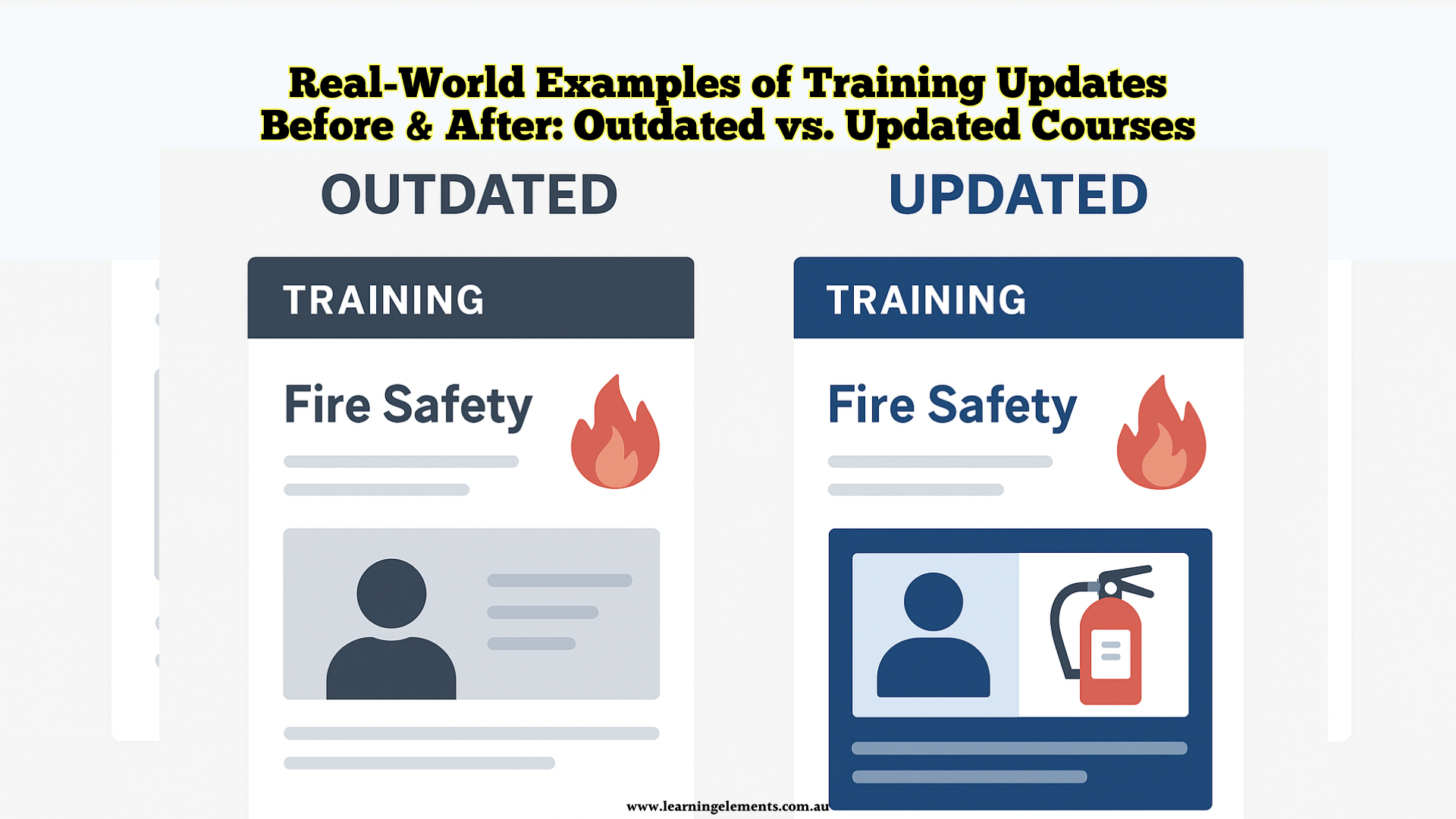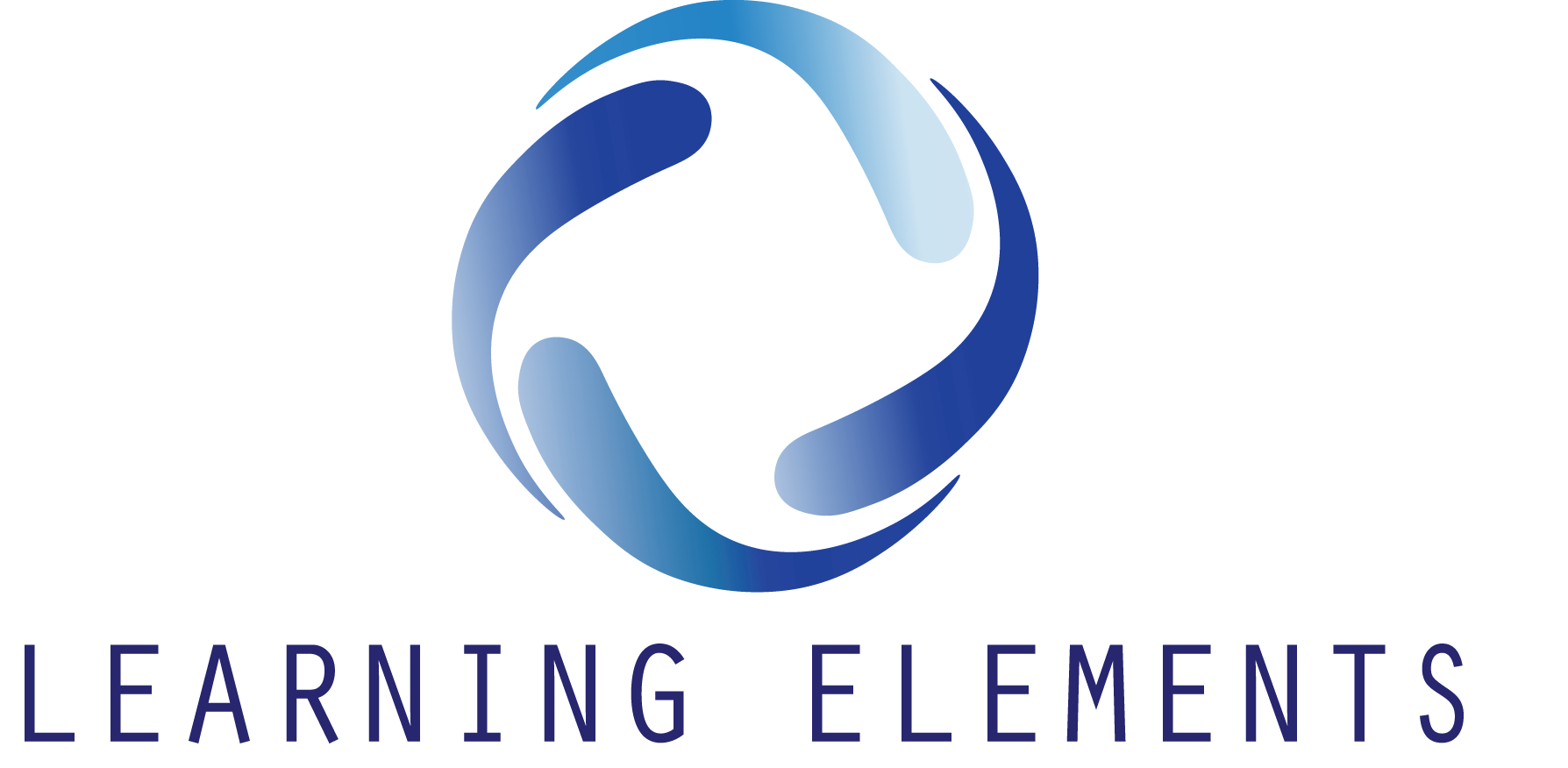Designing Training That Lasts: How to Maintain & Update Course Materials Over Time
In today’s fast-paced workplaces, designing training that lasts is more important than ever. Organisations across Australia are investing heavily in training programs, yet too often these resources become outdated, irrelevant, or inconsistent within just a year or two. That’s wasted effort, time, and money.
The solution? Strong instructional design paired with future-proof strategies to maintain training materials, update course content, and implement course update best practice. With the right systems in place, you can ensure employees stay engaged, compliant, and equipped with current knowledge—whether through in-person programs or when you update eLearning courses.
In this guide, we’ll cover proven approaches, including version control methods, content tagging, review cycles, and modular design for easy updates, supported by real-world examples that show the business impact of keeping training updated.
Why Training Needs Regular Updates
Training is a living resource. Workplaces evolve, digital platforms and compliance requirements frequently change. If training doesn’t keep pace, employees risk using outdated information that could compromise productivity, safety, or compliance.
Maintaining and updating training materials is crucial to:
- Compliance with legislation like WHS laws and privacy regulations
- Accurate knowledge aligned to current tools, processes, and technologies
- Training that reflects organisational goals and current policies
- Better learner engagement through fresh, relevant content
- Reduced risk of workplace errors and reputational damage
For instance, consider a safety course that hasn’t been updated since 2018. An employee trained on outdated fire safety measures could unintentionally follow incorrect procedures—putting themselves and colleagues at risk. This highlights why knowing how to maintain course materials isn’t just good practice, but essential.
The Role of Design in Lasting Training
Designing training that lasts isn’t just about keeping content fresh—it’s about structuring courses in a way that makes updates simple and sustainable. A well-designed program anticipates change, whether it’s new compliance rules, evolving technology, or updated workplace policies. By embedding flexibility from the beginning, organisations can reduce the time and cost of updates, while keeping learning engaging and relevant. This is where instructional design comes in. It provides the framework for creating training that not only delivers immediate results but can also adapt to future needs.
When training is built with structured design principles from the start, updating it later becomes more efficient and less disruptive.
What Is Instructional Design?
Instructional design is the structured process of creating effective learning experiences. It combines educational psychology, workplace needs, and delivery methods to ensure training is both engaging and measurable.
- Learning objectives that clearly define outcomes
- Content organisation that moves logically from basic to advanced topics
- Learning elements such as case studies, storytelling, gamification, and assessments
- Feedback loops to measure and improve effectiveness
By applying instructional design, trainers can not only update eLearning courses effectively but also ensure in-person and hybrid programs maintain continuity as business needs evolve.

Key Benefits of Keeping Training Current
Compliance Assurance
Keeping training materials current is important for meeting Australia’s ever-evolving regulatory requirements. From WHS laws to privacy regulations and Fair Work obligations, organisations face significant risks if employees are working with outdated knowledge. Penalties for non-compliance can be costly—not just financially, but also in terms of reputational damage. Updated training ensures staff understand the latest legislation and internal policies, reducing the likelihood of errors that could lead to fines or legal disputes. For industries such as healthcare, construction, and finance, compliance assurance is not just a benefit—it’s a business necessity.
Employee Confidence
When training reflects the actual tools, technologies, and policies that employees use daily, it builds a sense of trust and confidence in the learning process. Workers are more likely to apply training in their roles when they see its direct relevance to their tasks. Outdated modules, by contrast, can leave staff second-guessing whether they’re doing things “the right way.” By regularly updating training, organisations send a clear message that they value their employees’ development and are committed to keeping them well-equipped. This boost in confidence often translates into better performance and higher morale across teams.
Operational Efficiency
Stale training often leads to workflow inefficiencies, with employees spending extra time correcting mistakes or navigating outdated processes. Updated training reduces these risks by ensuring staff are aligned with the most effective methods and technologies available. For example, when a business introduces a new digital platform, updating the training immediately helps employees adopt it faster and more smoothly. Over time, this translates into greater productivity, reduced error rates, and less rework—saving both time and resources.
Higher ROI on Training
Training is a major investment for organisations, and its value should extend beyond the initial launch. With modular design for easy updates, companies don’t need to start from scratch every time a policy or tool changes. Instead, they can update only the relevant sections, keeping costs down while still delivering fresh, relevant learning. This approach maximises the return on investment (ROI) for training programs, as resources spent on development continue to generate value long after the initial rollout. It also makes budget forecasting more predictable, since smaller, incremental updates replace expensive full-course redesigns.
Stronger Engagement
Learners are more motivated to complete training when it feels modern, interactive, and aligned with their real-world challenges. Outdated slides and text-heavy modules often lead to disengagement and low completion rates. By contrast, fresh content—enhanced with videos, quizzes, or industry-specific case studies—keeps learners attentive and invested in the experience. Regular updates also demonstrate that training is not a “tick-the-box” exercise, but a genuine effort to support employees’ growth. Stronger engagement not only improves knowledge retention but also helps build a positive learning culture within the organisation.
If you’re committed to designing training that lasts, we can help you enhance your programs and align them with today’s evolving requirements.
Want to know if your training materials are still relevant? Schedule a FREE 30-minute consultation with us today!
Common Challenges in Maintaining Training Materials
Outdated Content Risks
One of the most frequent challenges in designing training that lasts is keeping materials current and responsive to change. Business priorities shift rapidly—whether it’s new technology, updated regulations, or changing market conditions—and training often lags behind. When content isn’t updated, it quickly becomes irrelevant or even misleading.
For example, a compliance module that references legislation from five years ago could leave employees unknowingly breaching current laws. Outdated training not only damages credibility—since learners lose trust when content doesn’t reflect their day-to-day reality—but it also exposes organisations to serious risks. Compliance breaches, safety hazards, workplace errors, and wasted investment in ineffective programs are all common outcomes of letting training go stale.
Version Confusion
Without proper version control methods, multiple versions of training materials often circulate at the same time. It’s not uncommon for staff to be working from different PDFs, outdated PowerPoint decks, or older eLearning modules while managers assume everyone is aligned. This creates inconsistencies in knowledge, uneven performance across teams, and in regulated industries, potential compliance violations. Version confusion also wastes time, as trainers must constantly check and verify which resources are current. Implementing structured version control processes is key to solving this challenge.
Learner Engagement Drops
Stale content impacts motivation. Learners are more likely to disengage if training doesn’t reflect their real world challenges. Workers can easily recognise when training has not been updated. It often contains old screenshots, outdated language, or scenarios that no longer align with the tools and processes they use every day. When this happens, training starts to feel like a tick the box activity rather than something that adds real value to their role. The result is lower completion rates, reduced knowledge retention, and ultimately, a weaker return on investment for the organisation. To prevent this, training needs to be refreshed regularly with relevant examples, interactive elements, and content that speaks directly to the learner’s current work environment.
Resource Constraints
Maintaining and updating training materials requires time, funding, and skilled expertise. Many organisations put off updates because instructional designers, trainers, and SMEs are already stretched thin. This delay often results in content becoming even more outdated, creating a bigger problem down the track. Smaller businesses in particular may struggle to allocate a dedicated budget or staff for regular reviews. Without a structured process, updates often get pushed aside in favour of other business priorities.
Scalability Across Teams
For organisations with large or geographically dispersed workforces, ensuring that all employees receive updated training is a significant challenge. Remote and hybrid teams add another layer of complexity with time zones, varied access to technology, and differences in local regulations. An update that works seamlessly for one department may not translate effectively across the wider organisation. This makes scalability one of the trickiest parts of maintaining consistent and effective training.
Technology Integration Issues
Many businesses use multiple platforms to manage learning—such as an LMS, HR software, and cloud storage systems. If these platforms aren’t well integrated, outdated training versions may remain accessible in certain systems, leading to confusion. For example, a team might access an old PDF in SharePoint while another uses the updated version in Moodle. Lack of integration increases administrative workload and creates inconsistencies in what learners are taught.
Regulatory and Compliance Pressure
Compliance training is particularly vulnerable to rapid change. In Australia, legislation such as WHS laws and privacy regulations frequently evolves, and organisations must ensure their content reflects the latest requirements. If compliance modules aren’t updated promptly, employees risk breaching laws without even realising it. Beyond legal penalties, this also exposes organisations to reputational damage and loss of stakeholder trust. Keeping pace with compliance updates is not optional—it’s critical.
Measuring Effectiveness of Updates
Even after updating training materials, many organisations struggle to determine whether the changes actually improved learning outcomes. Without clear metrics, updates may feel like they are done for the sake of activity rather than impact. Ideally, organisations should connect LMS data (like completion rates and quiz scores) with business outcomes such as productivity, safety incidents, or compliance audit results. Without this feedback loop, it’s hard to know if updates are truly delivering value.
Best Practices for Updating Training Content
Implementing Version Control Methods
Just like software, training materials need version control. Using document management systems or Learning Management Systems (LMS) platforms ensures everyone accesses the latest version.
Using Content Tagging for Easy Search
Tagging content with keywords like “safety,” “compliance,” or “customer service” makes it easier to locate and update modules without hunting through multiple files.This saves hours otherwise wasted digging through archives.
Establishing Review Cycles
Scheduled review cycles—quarterly for compliance-heavy content, annually for general training—help keep materials fresh. Involving Subject Matter Experts (SMEs) ensures accuracy and alignment with current industry standards.
Designing Modular Training Content
Break down courses into smaller modules. Instead of updating an entire course, you can simply swap out outdated sections. This saves time and maintains consistency. For example, replacing a section on outdated software features without reworking the whole program. This is a course update best practice embraced by many large organisations.
Storyboarding for Smarter Updates
Storyboards in instructional design helps ensure training is both engaging and easy to update. By mapping out the flow of modules, interactions, and assessments before development begins, designers can build courses with modular design in mind. For example, if compliance rules change, a storyboard makes it simple to pinpoint exactly where that content lives in the course, so updates can be made without overhauling everything else. Storyboarding also helps align stakeholders such as SMEs, compliance officers, and trainers, ensuring everyone agrees on the structure and content before time and resources are invested in development.

Real-World Examples of Training Updates
Before & After: Outdated vs. Updated Courses
A company delivering software training might once have included screenshots of a platform’s old interface. After an update, the team redesigned the module with new images, interactive demos, and real life scenarios. This led to better learner adoption. This change highlights how even small improvements, such as replacing static slides with interactive walkthroughs, can significantly boost learner confidence and retention. Employees reported feeling more capable when using the new system, because the training mirrored the actual tools they were working with. For the organisation, the updated training reduced support requests and sped up onboarding times, proving that designing training that lasts requires a balance of accuracy, relevance, and learner-centred design.
Lessons from Leading Organisations
Top companies like Google and Atlassian use modular design and tagging systems to streamline updates. They treat training as an ongoing cycle, not a one-time event. Google applies modular principles through its Material Design system, which allows for consistent yet adaptable updates across its products and training resources. Atlassian, well known in Australia for tools like Jira and Confluence, uses tagging and modular content to manage continuous updates across its SaaS platforms, ensuring both staff and customers have access to current information.
Deloitte has invested heavily in reshaping its learning and development programs, including a $1.4 billion initiative known as Project 120. This program is designed to create a more agile, digital, and future-ready workforce by ensuring learning is updated continuously rather than delivered as one-off training.
The Australian National University (ANU) has also demonstrated the value of continuous updates through its work in telehealth education. By aligning training with evolving technologies and clinical practices, ANU ensured that learners gained practical, up-to-date knowledge that could be applied directly in the workplace.
Tools & Platforms for Course Maintenance
LMS Features That Help
Modern Learning Management Systems (LMS) play a crucial role in ensuring training materials remain accurate, accessible, and up to date. Many platforms, including Moodle, Totara, and Canvas, are widely used in Australia by both enterprises and universities because of their reliability and adaptability. Additionally, LMS platforms provide automatic notifications and reminders, which prompt administrators when a module needs to be reviewed or updated, ensuring no content is left behind. Advanced analytics tools also highlight underperforming modules, making it easier to identify where learner engagement is dropping and where updates should be prioritised.
Collaboration & Workflow Tools
While an LMS ensures training content is delivered and tracked, collaboration and workflow tools make it easier for teams to manage the process of updates and reviews. Platforms like Trello, Confluence, and SharePoint allow multiple stakeholders—such as instructional designers, SMEs, and compliance officers—to collaborate in real time. These tools make it simple to assign responsibilities, monitor who is updating specific modules, and document every change for accountability. They also improve communication across teams, reducing delays that often occur when updates are managed over email or scattered files.
Content Authoring Tools
Updating a course doesn’t always mean starting from scratch, and that’s where content authoring tools shine. Programs such as Articulate 360, Adobe Captivate, and iSpring allow instructional designers to quickly edit, refresh, or expand course content without having to rebuild entire modules. These tools support modular design for easy updates, making it simple to replace outdated sections with new information while maintaining consistency. Many authoring tools also integrate directly with LMS platforms, streamlining the publishing process. This reduces the workload for training teams and ensures updates can be rolled out quickly across dispersed workforces.
AI and Automation Tools
The use of AI and automation in course maintenance is rapidly growing and offers huge potential benefits. Some LMS now use artificial intelligence to automatically flag content that is outdated, underperforming, or inconsistent with learner needs. Automation can also send real-time notifications when new policies or technologies require updates to specific training modules. AI-driven analytics provide deeper insights into learner performance, helping trainers pinpoint exactly where updates will have the greatest impact. For organisations with large or complex training libraries, AI and automation reduce the manual burden of content audits and make it easier to maintain training materials at scale.
Compliance & Policy Management Systems
In highly regulated industries, compliance must be at the heart of any training program. Compliance and policy management systems can be integrated with training platforms to ensure that whenever legislation or internal policies change, the related training modules are updated immediately. This is especially relevant in Australia, where WHS laws, Fair Work obligations, and the Privacy Act frequently shape workforce training requirements. These systems act as a safeguard, reducing the lag between a policy update and its translation into employee learning. By embedding compliance tools into the training workflow, organisations can prevent costly errors and maintain trust with regulators and stakeholders.
Communication & Engagement Tools
Finally, even the best updates are only effective if learners actually engage with them. Platforms like Slack, Microsoft Teams, and Yammer can be integrated with training systems to notify employees about new or updated modules. These tools create a direct communication channel that reinforces the importance of completing training updates in a timely manner. They also support ongoing discussion and peer-to-peer learning, making training feel like part of everyday work rather than a one-off obligation.
How Learning Elements Support Training That Lasts
Adding the right learning elements ensures training updates don’t just refresh content, but also make it more effective and memorable. Here’s how specific approaches can support training that stands the test of time:
Scenario-Based Learning
Scenario-based modules immerse learners in realistic situations that mirror their workplace challenges. For example, a WHS training program in the construction industry might include scenarios about responding to onsite hazards. This method helps learners bridge the gap between theory and practice, encouraging them to apply knowledge in real-world contexts. Scenario-based learning also makes updates more meaningful—when examples are refreshed, learners immediately see their relevance to current practices.
Gamification and Quizzes
Gamification techniques—such as leaderboards, badges, or timed challenges—encourage healthy competition and boost motivation. Quizzes provide instant feedback, allowing learners to check their understanding and trainers to identify areas where further support is needed. When training is updated with new content, gamification helps ensure that employees engage with it enthusiastically rather than seeing it as another compliance task. It transforms updates into an opportunity for fun, rewarding learning.
Interactive Media
Incorporating videos, branching simulations, and live polls makes training more dynamic and easier to retain. For instance, a customer service training program might use branching scenarios where employees choose how to respond to a client’s complaint, receiving feedback on their decision. Interactive media not only captures attention but also supports different learning styles, making training accessible and engaging for a wider audience. Updates delivered through interactive formats tend to feel less like a chore and more like a valuable learning experience.
Case Studies with Local Context
Case studies provide concrete examples that help learners connect abstract principles to their industry and environment. For Australian organisations, case studies can highlight local compliance issues, workplace safety challenges, or industry-specific trends. For example, a training update for aged care staff might draw on a real-world case involving privacy breaches under the Australian Privacy Act. By including local and industry-relevant examples, case studies make updated training relatable and directly applicable to learners’ day-to-day roles.
Ongoing Support for Learners
Training doesn’t end once a course is completed—employees often need reinforcement, reminders, and access to help as they apply what they’ve learned in the workplace. Ongoing support can take many forms: microlearning refreshers, job aids, quick-reference guides, or digital performance support tools. Some organisations use learning management systems to schedule follow-up quizzes or reminders weeks after training, reinforcing retention. Others create peer-support forums or mentorship programs to provide learners with practical guidance on the job. By building ongoing support into the learning strategy, organisations not only maintain training materials but also ensure knowledge sticks, reducing the risk of errors and boosting overall performance.
Ready to make your training more interactive and engaging?
Speak to our team of instructional design specialists about updating your courses with proven learning strategies.
FAQs
- How often should training content be reviewed? At least once a year, though compliance-driven training (e.g., WHS, privacy laws) may require quarterly reviews.
- What’s the best way to keep track of updates? Implement version control methods and maintain a change log accessible to trainers and managers.
- How can I make updates faster? Adopt modular design for easy updates—replace only what’s outdated, not the whole course.
- Do I need a dedicated team for updates? Not necessarily. SMEs can work alongside instructional designers to streamline updates and apply course update best practice.
- How do I know if my course is outdated? Check learner feedback, monitor performance gaps, and assess whether training examples align with current workflows.
- What’s the role of technology in maintaining training? LMS platforms, content tagging, and AI-powered analytics can flag outdated modules and suggest areas for improvement.
Conclusion
Designing training that lasts comes down to creating learning programs that are flexible, relevant, and built to grow alongside your organisation. Training needs regular updates to stay relevant, yet organisations often face challenges like outdated content, version confusion, and drops in learner engagement. By understanding these risks, teams can take a more proactive approach. Best practices such as structured review processes, modular updates, and smarter use of tools and platforms make maintaining course materials far more manageable. Have a clear goal! Align training with organisational needs, learner expectations, and industry standards.
Investing in long-term training maintenance helps employees perform better, improves ROI, and keeps businesses competitive.
Don’t let outdated content hold your business back. Whether it’s compliance, technology, or engagement, we’ll help you design training that lasts. Partner with us to start designing training that lasts today!
Sources
- PR Newswire – With $1.4B Investment, Deloitte Looks to Reshape the Future of Learning and Development
- HRDive – While workers need skill development, managers still lack support, Deloitte says
- The Australian National University – Stevenson, D. (2008). Training and process change: A collaborative telehealth case study. In Proceedings of the 20th Australasian Conference on Computer-Human Interaction: Designing for Habitus and Habitat, OZCHI’08 (pp. 65-72). (Proceedings of the 20th Australasian Conference on Computer-Human Interaction: Designing for Habitus and Habitat, OZCHI’08). https://doi.org/10.1145/1517744.1517765
- Google – Material Design 3
- Atlassian – Confluence: Building better content libraries with Confluence databases
- Australian Government – Work Health and Safety Act 2011


